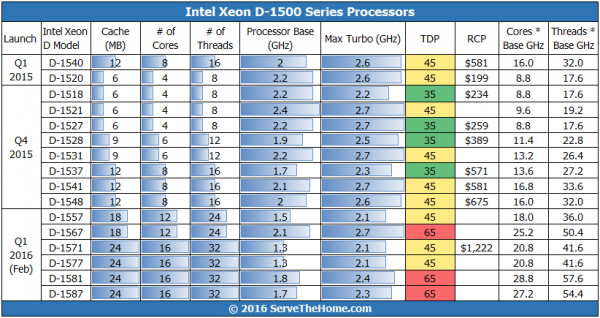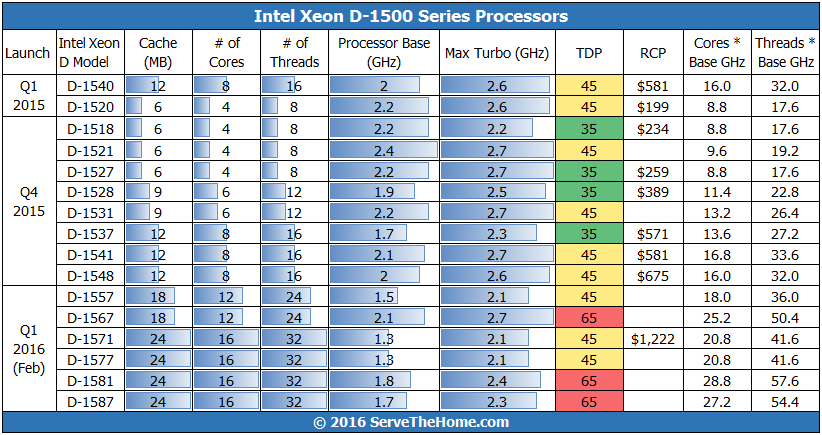Earlier this week we posted updates to four of the Intel Xeon D-1500 series chips that had been added to ARK. This week I was with several Intel marketing and press relations folks for a workshop and mentioned that ARK was not fully updated. The D-1557 and D-1567 did not have official specs listed on ark.intel.com and the Intel Xeon D family pages only linked two of the six new chips. By mid-week I had confirmation that indeed all six new chips we first discussed in February were launched. I also received confirmation that they should be on ARK and that the matter was being escalated. Today we are finally able to provide official specs on the new chips as they can be found on Intel ARK.
Here is the finalized chart comparing the three tranches of chips released thus far in the Intel Xeon D-1500 series.

Now that this picture is complete we can see a few patterns emerge. First off, The D-1567 looks extremely interesting with 12 cores and 24 threads but a higher clock speed. It may be the top option for someone looking for a low power high core count compact desktop replacement.
The higher-end chips are great in that they support a solid number of threads, however, one has to remember that the overall market for 16 core / 32 thread virtualization servers with only 128GB of RAM is somewhere in the 10% range. The majority of 16 core/ 32 thread virtualization servers run 256-512GB of RAM. There are many applications that will fit within 8GB/ core or 4GB/ thread envelopes but with that many cores, it would have been nice to see more RAM capacity on the new chips.
As we move to DDR4-2400 RAM we will also see a process shrink on the DRAM side which should mean DDR4 prices continuing to fall and LRDIMMs reaching 128GB per module. We will also expect see power consumption per RDIMM module fall by about 0.2w per module or 12-13%. The general consensus among analysts I have spoken to is that the 128GB limit of the Intel Xeon D series is one that is awaiting competition. As soon as an ARM or other alternative comes out supporting more RAM we may see the Xeon D get a 256GB or 512GB limit.
Also, the Intel Xeon D-1500 family is now just about a year old and our sense is that any Xeon D chips released in the near future will continue to be Broadwell based. At some point, this extremely successful family of processors will make the transition to Skylake or newer architectures. On the other hand, embedded applications for networking and storage applications often require 7 year or longer lifecycles. Until the release of a new Intel Xeon E5-2600 generation, the Intel Xeon D-1500 benefits from a newer process (14nm) and newer core (Broadwell) that give it a solid IPC advantage over the E5 line. As we saw benchmarking the Intel Xeon D-1587, the 16 core / 32 thread Xeon D’s are a significant threat to the low end of the Xeon E5 lineup.




